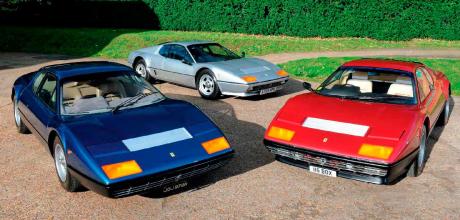Ferrari Boxers 1974 365 GT4 BB vs. 1978 512 BB and 1983 512 BBi
It’s very rare to gather all three major evolutions of Ferrari Berlinetta Boxer together – even more so in right-hand drive. We’re still pinching ourselves that we’ve driven them all, but which one delivers the knockout punch for us? Story by Chris Rees. Photography by Michael Ward.
Ticking all the Boxers
FERRARI BERLINETTA BOXER
Triple test: 365 GT4 BB v 512 BB v 512 BBi
No doubt about it: the golden year of the supercar was 50 years ago. In 1971, both Lamborghini and Ferrari revealed their epoch-setting new supercars, the former with the Countach and the latter with the 365 GT4 BB. Ferrari’s unveiling at the November 1971 Turin Show saw Leonardo Fioravanti’s masterful design revealed: a shape of exquisitely understated beauty. Officially the ‘BB’ bit meant Berlinetta Boxer, alluding to the new engine with its 12 opposed cylinders, but the story goes that internally, BB stood for Brigitte Bardot, the reputed muse for the design. The new Ferrari didn’t make production until two years later, in 1973. The UK launch price was £15,492, making this the second most expensive car on sale at the time, short of a Rolls-Royce Phantom VI.
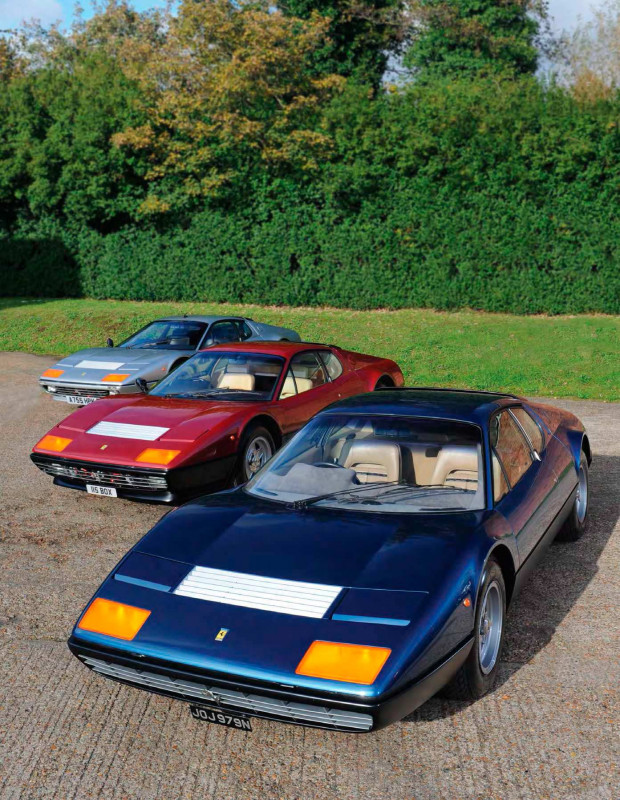
The first conundrum to answer is whether the 365 GT4 BB should be regarded as Ferrari’s first ever mid-engined road car. Arguably the 250 LM of 1963 was the first but this was really a racing car that could only notionally be used on the road. Then there was the Dino 206 GT of 1967 – but that never wore Ferrari badges. So yes, strictly speaking, the BB was a truly historic pioneer from Maranello.
The engine sounds amazing – like an early 1970s Formula 1 car – especially with its very rare triple-branch exhausts
The F102 engine was also pioneering, being Ferrari’s first ever flat-12 engine. And here’s our second conundrum: it’s not in fact a ‘flat’ format but instead a V12 whose angle of ‘vee’ is 180 degrees. The 365 GT4 BB was the very last car to be launched with Ferrari’s traditional numbering system based on individual cylinder capacity (365cc). In 1976, the 512 BB would switch to Maranello’s new system, indicating five litres and 12 cylinders, as the original 4.4-litre engine was expanded both in bore and stroke, rising from 4390cc to 4943cc.
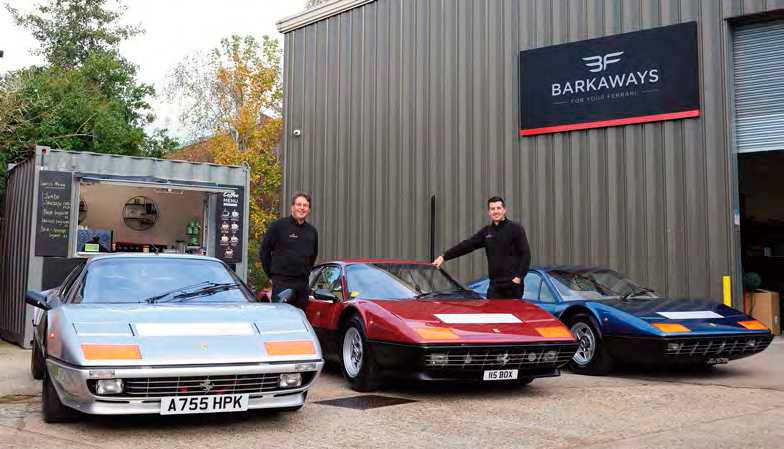
Today, the Berlinetta Boxer looks no less sensational on the road than it did in the 1970s: perfect proportions; lithe, low shape unadorned by appendages; huge SIEM front indicators looking like the Millennium Falcon is approaching. The fact that only minor adjustments were made to the styling throughout the BB’s lifespan is a testament to how essentially right the original shape was.
Here we have a delicious, and not often gathered group: all three main versions of the BB that Ferrari made: 365, 512 carb and 512 injection. Having just driven them all back to back, we can report that they all have distinct characters – in some respects surprisingly divergent. But which one is our favourite? It’s time to find out.
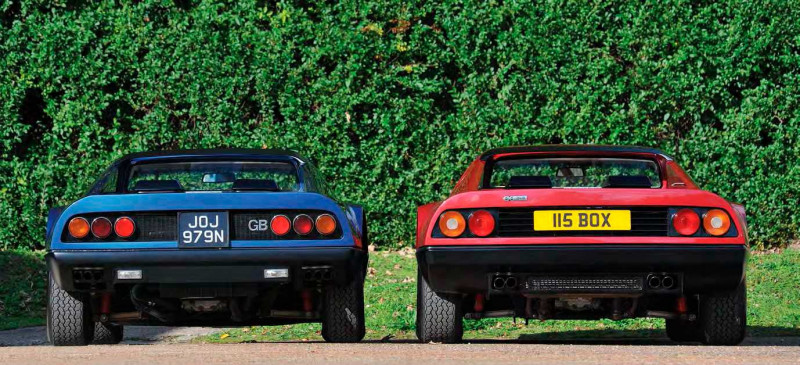
ORIGINS: 365 GT4 BB
Purest of form, truest to Fioravanti’s original vision, this 365 is one of the very earliest, dating from June 1974. It’s in superb condition – as attested by appearances at Salon Privé and the London Concours – and it looks resplendent in its Blu Dino Metallizato paint (a 2013 return to its original shade from a red repaint). Not that this is a mollycoddled show example, as owner Paul Maudsley affirms: “I don’t believe in cars sitting still. I drive it regularly and I’ve even taken it to France. The reputation for being fragile is largely undeserved. Respect it and it’s fine, even in heavy traffic. I like it more and more as time goes by and it’s definitely a keeper.”

Those early, pure looks make the best of the short 2500mm wheelbase, sharpened by a shorter rear overhang than the later cars.
Those wonderful triple rear lights and the black lower glassfibre bodywork somehow look more ‘correct’ than the two-light, all-one-colour later cars. Pull the door handle and the cabin that greets you is unmistakably from the heart of the 1970s: dials calibrated in bright orange; all-black, squared-shaped facia; and amazing-looking curved banana seats. However, these early chairs are anything but amazing to sit in because the backrests are fixed and there are no headrests. Having said that, my 5ft 8in frame fits just fine, but if you’re tall I can foresee all sorts of problems. Likewise for longer journeys: you’ll find muscles in your back aching that you never even knew were there. And the metal-and-leather steering wheel sits unavoidably close to your legs, which are skewed to one side to reach the tiny, awkwardly offset pedals.
There’s air conditioning here, even if the controls are ultra-stiff, and even if the system has been required to be converted to modern gas. There’s a dashboard clock, too, which announces itself by ticking as loudly as a disaster movie time-bomb.
Time to fire the beast up – far from straightforward. First, you need all four triple-downdraught carbs to be set up perfectly. If they’re not, the engine might never start. Even with flawlessly tuned carbs, the procedure proscribed by Ian Barkaway is very particular: almost flood the carbs by priming them with five dabs of the throttle pedal, then turn the key to start it with a modicum of throttle applied. If it doesn’t fire first time, it’s quite likely to need some time to recover before you try again.
Another thing to double-check before heading off is that the engine cover is properly shut. Should the rearward-opening lid (now unobtainable) unhinge at speed, it would become a very expensive air brake. This being such an early car, it has a cable-operated single-plate clutch (later ones had hydraulic twin-plate items), so you need a beefy left calf. But take care: it can be tricky to get the car cleanly off the line. Your foot needs to be gentle; if you’re clumsy, the clutch can be destroyed in minutes. The 4.4-litre engine sounds amazing, just like an early 1970s Formula 1 car. The growling crescendo of perfectly matched, interlacing mechanical noises is simply intoxicating. This example has the very rare original-type triple-branch exhaust system; it’s rare because most have been converted to twin-branch systems. Ian Barkaway had to fabricate the original-type system from scratch, with a huge amount of plumbing involved. It has a rasp that’s quite distinct in this trio.
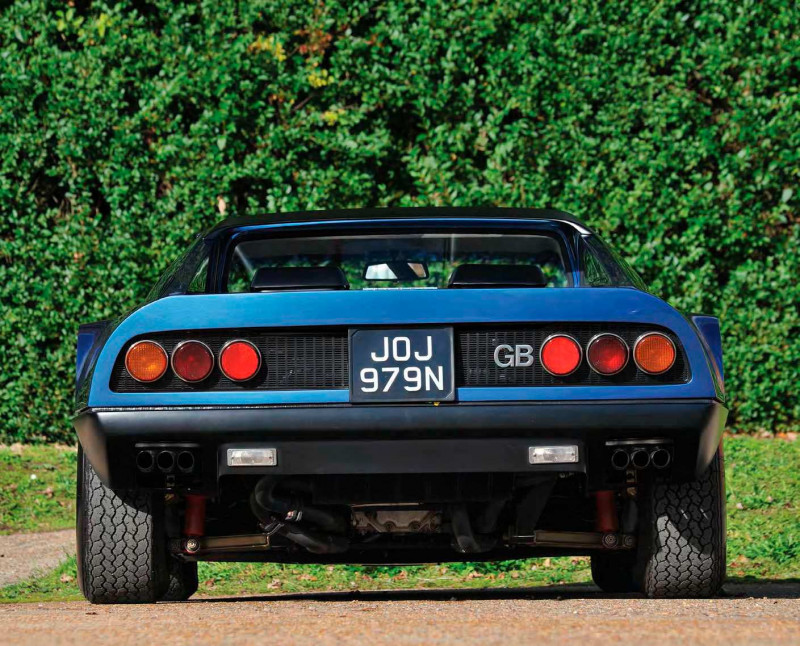
The engine revs higher than the later cars, too, with a redline set at 7500rpm. It’s not a peaky power curve by any means, though. Indeed, it feels beautifully linear throughout the rev range. But it really comes alive above 5000rpm, with those upper 2500rpm so sweet and juicy that you’ll be squeezing the trigger to reach there at every opportunity.
The slim chromed gear lever not only looks great, it feels just right, too. Snick it into dogleg first and then enjoy how joyously tightly it moves around its open gate (at least, once you’ve got used to its mechanicalistic notchiness). The gearing is relaxed: 2000rpm equates to 50mph in top gear, so it’s quite easy to have a conversation at motorway speeds and it’s a comfortable 100mph cruiser in that respect. Just don’t expect it to reach anything like the original claimed top speed of 188mph. That was only ever an optimistic ‘theoretical’ v-max – 175mph is a more realistic figure.
It’s not just in terms of power delivery that the 365 feels the sportiest of the trio, but in handling, too. The non-assisted steering is very heavy, and not just at parking speeds: as I negotiate my first roundabout at 30mph, I’m taken aback by how much heft I need to apply. That’s perhaps surprising considering that the 365 sports relatively narrow 7.5-inch wide wheels. These are shod with Michelin XWX 215/70 VR15 front tyres and 225/70 VR15 rears, whose ‘70’ figure gives you some clue as to how differently they behave compared to modern rubber-band tyres: the high profile might have Formula 1 echoes but when you turn in enthusiastically there’s an uneasy ‘wobble’. Flex in the tyre walls combines with quite a bit of body roll, making judging turn-in speeds something of an art form. At speed the steering delivers superb feel, with a very linear action through the wheel, while another plus is the excellent ground clearance, which means you can negotiate bumpy roads and sleeping policemen with quiet confidence.
One note of warning, though. Suddenly lifting off the throttle, or overenthusiastically applying it during cornering, can result in the BB wagging its tail. Oversteer lurks ominously, ready to bite if you get it wrong. That’s partly because so much weight sits over the rear axle (60%) but mostly because that weight sits quite high up, a corollary of the gearbox being slung underneath the engine. As for the brakes, the servo-assisted vented discs with four-pot callipers are superb by 1970s standards – even if you have to leave a little more tarmac than you’d expect in a modern car – and the pedal feel lets you know exactly what’s going on.
FIVE LITRES: 512 BB
Time to move on to the 512 BB and the superb 1978 example owned by Stephen Banks, who traded a 575 Superamerica for it. It’s been fully restored (at huge expense) and has Ferrari Classiche certification via Hexagon in the UK. “It’s not so valuable that you feel you can’t drive it,” says Stephen, “and with 26,000 miles on the clock, I feel happy doing so. It’s surprisingly practical and I use it at weekends and for occasional long runs.” It’s painted in its original factory shade of Rosso Rubino, a rosy red that we love and which its owner has “grown to like” (he prefers metallic grey personally). The rear overhang is longer by about 1.5 inches, giving it a less sporty look but perhaps more balanced overall. Other differences include body-coloured lower bodywork, NACA ducts moved behind the front wheels, a different front spoiler, twin rear lights (shared with the 308 and F40) and far more grilles on the engine cover (baffling since overheating was never really an issue on the 365). And on the rump is a badge so achingly 1970s, so beautifully graphic, that it ranks as one of the coolest ever applied to a car. Stepping inside, the same dials greet you (in fact, all three cars share the same gauges) but a distinct boon is the more comfortable driving position because – hooray! – you have reclining seats, even if they don’t boast a whole lot of adjustment.
The 512 BB has dry-sump lubrication and an extra 552cc of cubic capacity compared to the 365, which gives it advantages in terms of both power and torque. The extra torque is immediately obvious, especially in the lower rev range, where it pulls much more strongly. The lower redline (6800rpm) hints at the slightly less revvy nature of this larger engine. It’s still super-smooth but doesn’t have the crisp edge of the earlier 365, something driven home by the two-branch exhaust system that sounds a little more muted. Overall, it’s surprising how refined the 512 feels alongside the earlier car, yet the four carbs provide a superb induction noise and a feeling of rawness that the later, fuel-injected BBi lacks. With higher gearing, this is an easier car to drive than the 365, requiring fewer of those energy-sapping gearchanges. In terms of pace, the extra 14 horses and beefier torque curve make it clearly a quicker machine than the 365, although its 0- 62mph time of 6.2 seconds would barely see off a well-driven diesel these days. The handling is much the same as the 365 – not too surprising since mechanically it’s pretty much identical and it has the same tyres. One difference is that the differential is bigger and beefier than the 365’s, reputedly because early diffs were prone to breaking, but Ian Barkaway has never seen a bust diff in his 30 years in the business.
INJECTION OF INTEREST: 512 BBi
While our blue 365 is one of the earliest BBs, the Argento Auteuil 512 BBi is almost the last off the line, being manufactured in late 1983 (though not registered until 1984). There are plenty of subtle differences when you look closely: unique rear bumper, black-coloured NACA duct, body-coloured mirror to a new design, exposed front driving lights, new exhaust shroud and wider engine grilles (because the engine air boxes were relocated). Carbs give way to Bosch fuel injection.
Peak revs drop again (to 6600rpm), while the power output is 20hp less (340hp). To drive, the contrasts of the fuel-injected set-up are sizeable. Unlike the elaborate starting procedure of the carb-fed BBs, the BBi is simplicity itself: just twist the key and it fires up. It’s much easier to get a clean takeoff from the line, too, with no hint of the spluttering that can sometimes afflict carbfed BBs. It’s also much easier to drive at low speeds, as well as being and more torquey, silky and flexible. The downside is that, on start-up, the sound is surprisingly muted.
Once it’s running at speed, the sound becomes meatier, without ever being obtrusive, overall remaining surprisingly quiet and refined. That at least gives you the opportunity to explore the fantastic period hi-fi graphic equalizer. If that makes the 512 BBi sound like it’s soft, that view is countered by a sharper level of throttle response and a faster gearshift quadrant. And while the top speed claim of 174mph is fractionally less than the earlier models, it certainly doesn’t feel like it’s a weaker performer.
Wider 9.0-inch wide wheels are the same size front and rear, boasting flatter spokes than the earlier design. Fitted with 240/55 VR415 Michelin TRX metric tyres (now impossible to source), the result is a slightly wider track front and rear. This all translates to a more planted feel around corners, with less uncertainty on turn-in, more grip through each apex and a flatter cornering stance. The steering is still weighty, though, and the BBi is clearly more prone to following ruts in the road.
RARE BEASTS: PRODUCTION
All BBs are rare, but the earliest incarnation – the 365 made from 1973 to 1976 – was the rarest of the trio, with only 387 made, of which just 58 were right-hand drive. The 512 BB was built from 1976 to 1981 in carburetted form, during which time 929 were made, 101 of them in RHD. In October 1981 came the fuel-injected 512 BBi, which lasted until 1984, by which point 1007 had been manufactured, making this the most numerous of the BB family. However, it is by contrast the rarest version in right-hand drive, with a mere 39 examples shifted.
BOXING ODDS: VALUES
What price a Boxer? It seems peculiar that BBs are so undervalued alongside other mid-engined supercar classics. A Countach LP400 these days is worth £700,000 to £900,000, whereas a BB struggles to make even a third of that. In terms of desirability, the market favours the 365 over the 512, and carb-fed 512s over fuel-injected ones (even though the 512 BBi is the rarest in right-hand drive form). Several 365s have been auctioned in the past 12 months, fetching between £210,000 and £300,000.
As for 512s, these fetch typically between £170,000 and £250,000.
Ian Barkaway explains: “The market barometer for 1970s Ferraris is the Daytona. Whenever that goes up or down, other Ferrari classics follow. A Dino is generally worth half a Daytona, with the BB slotting in somewhere below.”
Perhaps another reason for lower values is maintenance costs: be under no illusion as to how much you need to keep a BB going. The sodium valves on all engines are prone to breaking off, and if any BB engine goes pop, expect the bill to be in the tens of thousands. While valves, pistons and gaskets are all readily available, there are no new blocks or heads left, which means refurbishment – at vast expense.
VERDICT
In this Berlinetta boxing match, one fact shines very clearly: all three cars are searingly brilliant. But each one boasts it own particular character, both in terms of appearance and in how they drive, which means they are quite distinct.
Deciding which one is best is not an easy question to answer. It depends on what you want from your Berlinetta Boxer. The BBi is by far the easiest to live with. You don’t have to worry about awkward engine start-ups, you don’t need to change gear as often and it’s the most refined and willing of the trio to drive. This is the BB you’d undoubtedly choose for a long journey.
The carb-fed 512 is very nearly as relaxing to drive, with its tall gearing and plentiful torque, but the engine sounds more enticing and has a greater propensity for revving. But in my book, a car like the BB should be all about the occasion, the drama, the thrill. In this department, there’s a clear winner.
The 365 simply makes the biggest impression, with a seductive allure that’s impossible to resist. Perhaps I’m swayed by the sheer rarity value of such an early BB: the still-clear impact that the original car made on me as a kid back in 1971. But I think not. It’s the way the 365 drives that seals it for me. For all its flaws –awkward seats, heavy clutch, irksome carbs – that scintillantly high-revving engine and raw feel give me the biggest kick.
Original is so often best, and so it is with the Berlinetta Boxer. The 365 is simply purer to look at and more involving to drive. It’s a perfect combination of the delicacy of a Dino combined with a revvy 12-cylinder firecracker of an engine. And as the original Ferrari supercar, it succeeds in distilling what makes such an apparently ridiculous object so utterly sublime.
Many subtle changes mark BBi but the fuel injection makes biggest difference to how it drives and sounds.
Rosso Rubino paint looks very special. 5.0-litre engine has torque aplenty and is easier to drive.
This very early, concours standard 365 is utterly memorable to pilot: raw and urgent but also challenging.


